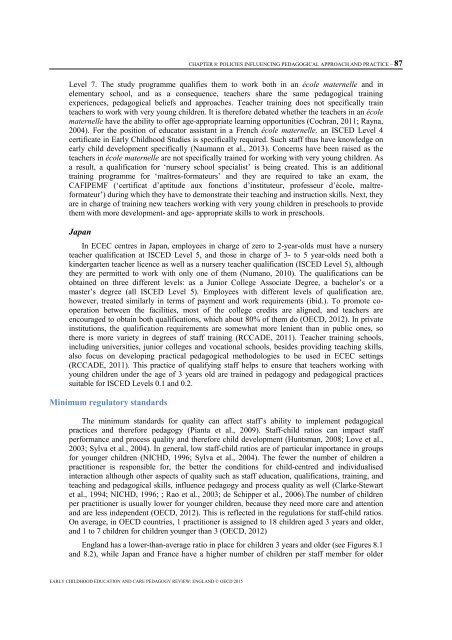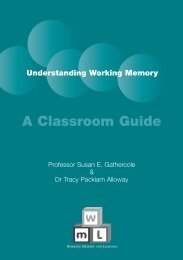early-childhood-education-and-care-pedagogy-review-england.pdf?utm_content=bufferb49b1&utm_medium=social&utm_source=twitter
early-childhood-education-and-care-pedagogy-review-england.pdf?utm_content=bufferb49b1&utm_medium=social&utm_source=twitter
early-childhood-education-and-care-pedagogy-review-england.pdf?utm_content=bufferb49b1&utm_medium=social&utm_source=twitter
You also want an ePaper? Increase the reach of your titles
YUMPU automatically turns print PDFs into web optimized ePapers that Google loves.
CHAPTER 8: POLICIES INFLUENCING PEDAGOGICAL APPROACH AND PRACTICE – 87Level 7. The study programme qualifies them to work both in an école maternelle <strong>and</strong> inelementary school, <strong>and</strong> as a consequence, teachers share the same pedagogical trainingexperiences, pedagogical beliefs <strong>and</strong> approaches. Teacher training does not specifically trainteachers to work with very young children. It is therefore debated whether the teachers in an écolematernelle have the ability to offer age-appropriate learning opportunities (Cochran, 2011; Rayna,2004). For the position of educator assistant in a French école maternelle, an ISCED Level 4certificate in Early Childhood Studies is specifically required. Such staff thus have knowledge on<strong>early</strong> child development specifically (Naumann et al., 2013). Concerns have been raised as theteachers in école maternelle are not specifically trained for working with very young children. Asa result, a qualification for ‘nursery school specialist’ is being created. This is an additionaltraining programme for ‘maîtres-formateurs’ <strong>and</strong> they are required to take an exam, theCAFIPEMF (‘certificat d’aptitude aux fonctions d’instituteur, professeur d’école, maîtreformateur’)during which they have to demonstrate their teaching <strong>and</strong> instruction skills. Next, theyare in charge of training new teachers working with very young children in preschools to providethem with more development- <strong>and</strong> age- appropriate skills to work in preschools.JapanIn ECEC centres in Japan, employees in charge of zero to 2-year-olds must have a nurseryteacher qualification at ISCED Level 5, <strong>and</strong> those in charge of 3- to 5 year-olds need both akindergarten teacher licence as well as a nursery teacher qualification (ISCED Level 5), althoughthey are permitted to work with only one of them (Numano, 2010). The qualifications can beobtained on three different levels: as a Junior College Associate Degree, a bachelor’s or amaster’s degree (all ISCED Level 5). Employees with different levels of qualification are,however, treated similarly in terms of payment <strong>and</strong> work requirements (ibid.). To promote cooperationbetween the facilities, most of the college credits are aligned, <strong>and</strong> teachers areencouraged to obtain both qualifications, which about 80% of them do (OECD, 2012). In privateinstitutions, the qualification requirements are somewhat more lenient than in public ones, sothere is more variety in degrees of staff training (RCCADE, 2011). Teacher training schools,including universities, junior colleges <strong>and</strong> vocational schools, besides providing teaching skills,also focus on developing practical pedagogical methodologies to be used in ECEC settings(RCCADE, 2011). This practice of qualifying staff helps to ensure that teachers working withyoung children under the age of 3 years old are trained in <strong>pedagogy</strong> <strong>and</strong> pedagogical practicessuitable for ISCED Levels 0.1 <strong>and</strong> 0.2.Minimum regulatory st<strong>and</strong>ardsThe minimum st<strong>and</strong>ards for quality can affect staff’s ability to implement pedagogicalpractices <strong>and</strong> therefore <strong>pedagogy</strong> (Pianta et al., 2009). Staff-child ratios can impact staffperformance <strong>and</strong> process quality <strong>and</strong> therefore child development (Huntsman, 2008; Love et al.,2003; Sylva et al., 2004). In general, low staff-child ratios are of particular importance in groupsfor younger children (NICHD, 1996; Sylva et al., 2004). The fewer the number of children apractitioner is responsible for, the better the conditions for child-centred <strong>and</strong> individualisedinteraction although other aspects of quality such as staff <strong>education</strong>, qualifications, training, <strong>and</strong>teaching <strong>and</strong> pedagogical skills, influence <strong>pedagogy</strong> <strong>and</strong> process quality as well (Clarke-Stewartet al., 1994; NICHD, 1996; ; Rao et al., 2003; de Schipper et al., 2006).The number of childrenper practitioner is usually lower for younger children, because they need more <strong>care</strong> <strong>and</strong> attention<strong>and</strong> are less independent (OECD, 2012). This is reflected in the regulations for staff-child ratios.On average, in OECD countries, 1 practitioner is assigned to 18 children aged 3 years <strong>and</strong> older,<strong>and</strong> 1 to 7 children for children younger than 3 (OECD, 2012)Engl<strong>and</strong> has a lower-than-average ratio in place for children 3 years <strong>and</strong> older (see Figures 8.1<strong>and</strong> 8.2), while Japan <strong>and</strong> France have a higher number of children per staff member for olderEARLY CHILDHOOD EDUCATION AND CARE PEDAGOGY REVIEW: ENGLAND © OECD 2015



